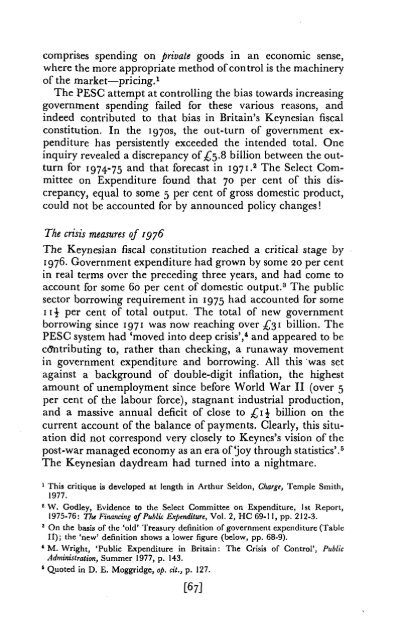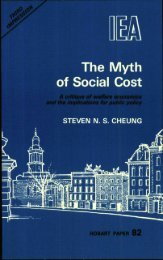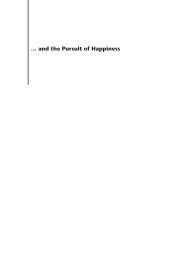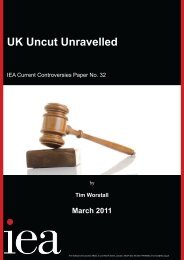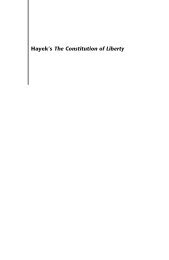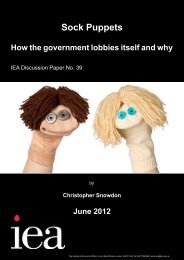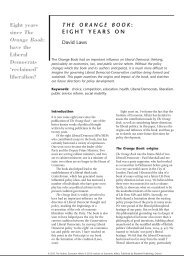THE CONSEQUENCES OF MR KEYNES.pdf - Institute of Economic ...
THE CONSEQUENCES OF MR KEYNES.pdf - Institute of Economic ...
THE CONSEQUENCES OF MR KEYNES.pdf - Institute of Economic ...
You also want an ePaper? Increase the reach of your titles
YUMPU automatically turns print PDFs into web optimized ePapers that Google loves.
comprises spending on private goods in an economic sense,<br />
where the more appropriate method <strong>of</strong> control is the machinery<br />
<strong>of</strong> the market—pricing. 1<br />
The PESC attempt at controlling the bias towards increasing<br />
government spending failed for these various reasons, and<br />
indeed contributed to that bias in Britain's Keynesian fiscal<br />
constitution. In the 1970s, the out-turn <strong>of</strong> government expenditure<br />
has persistently exceeded the intended total. One<br />
inquiry revealed a discrepancy <strong>of</strong> £5.8 billion between the outturn<br />
for 1974-75 and that forecast in 1971. 2 The Select Committee<br />
on Expenditure found that 70 per cent <strong>of</strong> this discrepancy,<br />
equal to some 5 per cent <strong>of</strong> gross domestic product,<br />
could not be accounted for by announced policy changes!<br />
The crisis measures <strong>of</strong> 1976<br />
The Keynesian fiscal constitution reached a critical stage by<br />
1976. Government expenditure had grown by some 20 per cent<br />
in real terms over the preceding three years, and had come to<br />
account for some 60 per cent <strong>of</strong> domestic output. 3 The public<br />
sector borrowing requirement in 1975 had accounted for some<br />
n-J- per cent <strong>of</strong> total output. The total <strong>of</strong> new government<br />
borrowing since 1971 was now reaching over £31 billion. The<br />
PESC system had 'moved into deep crisis', 4 and appeared to be<br />
contributing to, rather than checking, a runaway movement<br />
in government expenditure and borrowing. All this was set<br />
against a background <strong>of</strong> double-digit inflation, the highest<br />
amount <strong>of</strong> unemployment since before World War II (over 5<br />
per cent <strong>of</strong> the labour force), stagnant industrial production,<br />
and a massive annual deficit <strong>of</strong> close to £i\ billion on the<br />
current account <strong>of</strong> the balance <strong>of</strong> payments. Clearly, this situation<br />
did not correspond very closely to Keynes's vision <strong>of</strong> the<br />
post-war managed economy as an era <strong>of</strong>'joy through statistics'. 5<br />
The Keynesian daydream had turned into a nightmare.<br />
1 This critique is developed at length in Arthur Seldon, Charge, Temple Smith,<br />
1977.<br />
2 W. Godley, Evidence to the Select Committee on Expenditure, 1st Report,<br />
1975-76: TTie Financing qf Public Expenditure, Vol. 2, HC 69-11, pp. 212-3.<br />
3 On the basis <strong>of</strong> the 'old' Treasury definition <strong>of</strong> government expenditure (Table<br />
II); the 'new' definition shows a lower figure (below, pp. 68-9).<br />
* M. Wright, 'Public Expenditure in Britain: The Crisis <strong>of</strong> Control', Public<br />
Administration, Summer 1977, p. 143.<br />
5 Quoted in D. E. Moggridge, op. cit., p. 127.<br />
[67]


